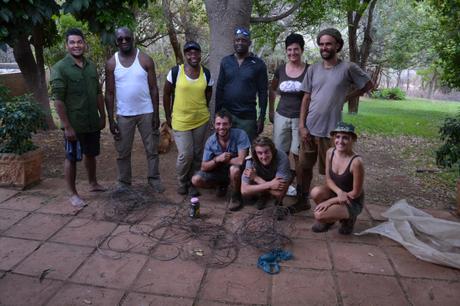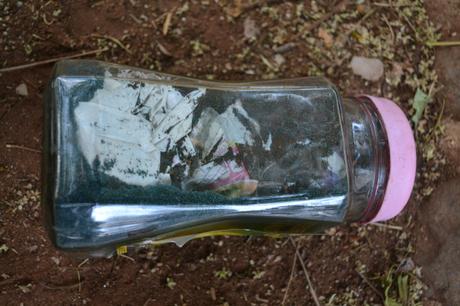Last Sunday (16 Oct 2016), Philip took our latest Earthwatch team to Medike Nature Reserve to conduct a snare sweep. What we found was not at all what we expected...
We left early in the morning for Medike (on what was possibly one of the hottest days this month) to meet up with Ryan van Huyssteen and his team. A two hour hike got us to a very beautiful waterfall and a forested riverine area where we started our snare sweep. The area is occasionally used by a local religious group for ceremonies and the waterfall is considered sacred by the Venda community in Kutama. When we started making our way down along the river line there was collective feeling among all of us that we will not find any snares and will have just exhausted ourselves. We then found two. Then another, and after three hours of searching for snares we ended up with several. By the time we finished and had to make our way back to reception we had lost track of how many we removed. We took turns to carry the snares on the two hour hike back. When we got back to reception we were welcomed with ice cold, homemade lemonade and peppermint-crisp tart. Lemonade has never tasted so good! We were anxious to know how many snares we had removed in such a short period so we counted them.
We had removed a total of 75 snares in just three hours!

People put out snares in order to catch animals mostly for food. However, snares are not target-specific and any animal can get caught and killed by a snare. Snares are also often forgotten about when people get a job or move to another area and can be left there for years before an animal gets trapped in it. It is an extremely horrible death for the animal and a very inhumane method of killing. However, social-ecological systems are highly complex as previous blog posts have described. The problem is not the people putting snares in the bush but the high unemployment rate and poverty of the neighbouring areas. As Maslow's hierarchy of needs have shown, people are inclined to meet their own basic needs before the needs of others (whether human or non-human). When you don't have food, conservation of wildlife is not your first priority. This is complicated even more by the idea that animals belong to humans and by the political tensions created years ago. However, this is not a topic we will elaborate on in this blog.
In addition to 75 snares, we also found a bottle of Temic poison! We scooped up all the poison from the ground and placed it in a plastic bag. Temic has been used by people in the past for various reasons. Some use it to kill predators as a form of retaliation against livestock depredation, house burglars use it to silence their canine victims, poachers have used it to kill rhinos in the past and may also use it to kill leopards and lions for their valuable skins and body parts, and so forth. Temic comprises of the chemical Aldicarb and falls in the super-toxin class, which means that it is highly toxic. It is used in the agricultural sectors as a pesticide. One teaspoon of temic can kill an adult rhino and 1 mg is enough to kill a rodent. What it was doing in the bush, we can only speculate...

So after a full day of Kalahari heat, near dehydration, and Jeff's rolling boulders, we removed 75 snares and a jar of temic poison. The PPP team in collaboration with Medike will be doing a follow-up snare sweep in the near future to double check the area.
If wildlife could speak, they would be giving thanks to everyone involved.
